#a3j-1 Vigilante
Video
RVAH-7 North American A3J-1 (RA-5C) Vigilante 149291 / Cutaway by Wing attack Plan R
Via Flickr:
The basis for this photo was found in the March 2001 edition of AIRPOWER magazine. The North American A-5 Vigilante was an American carrier-based supersonic bomber designed and built by North American Aviation for the United States Navy. It set several world records, including long-distance speed and altitude records. Prior to 1962 unification of Navy and Air Force designations, it was designated the A3J Vigilante. The aircraft only replaced the Douglas A-3 Skywarrior as the Navy's primary nuclear-strike aircraft briefly, however its RA-5C tactical strike reconnaissance variant saw extensive service during the Vietnam War. The reconnaissance version of the Vigilante, the RA-5C, had slightly greater wing area and added a long canoe-shaped fairing under the fuselage for a multi-sensor reconnaissance pack. This added an APD-7 side-looking airborne radar (SLAR), AAS-21 infrared line scanner, and camera packs, as well as improved electronic countermeasures. An AN/ALQ-61 electronic intelligence system could also be carried. The RA-5C retained the AN/ASB-12 bombing system, and could, in theory, carry weapons, although it never did in service. Later-build RA-5Cs had more powerful J79-10 engines with afterburning thrust of 17,900 lbf (80 kN). The reconnaissance Vigilante weighed almost five tons more than the strike version with almost the same thrust and an only modestly enlarged wing. These changes reduced its acceleration and climb rate, though it remained fast in level flight.
#A3J-1#RA-5C#Bu.No.149291#North_American_Aviation#Vigilante#RVAH-7#U.S.NAVY#Recon#Cutaway#USS_Constellation#Reconnaissance#Vietnam_War#High-speed_Nuclear_Attack_Bomber#flickr
5 notes
·
View notes
Text
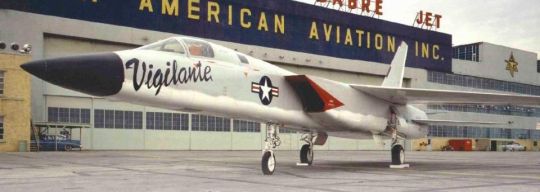
-An XA3J-1 at North American's factory during roll-out. Photo: North American Aviation
FLIGHTLINE: 152 - NORTH AMERICAN AVIATION A-5 VIGILANTE
Designed as a carrier-based supersonic bomber in the 1950s, the Vigilante saw service over Vietnam as a recon plane before being retired in 1979.
Development of what became the A-5 began in 1954 when North American Aviation started a internal program. Seeking to turn around the company's fortunes after the failed XA2J Super Savage, NAA began designing a Mach 2 capable bomber which would give the Navy a nuclear strike option. The initial design, known as the North American General Purpose Attack Weapon (NAGPAW) was evaluated by the US Navy, which replied with a series of needed changes and in July 1955 an initial design contract was awarded, which included a single mockup of the plane. NAA's engineers were able to successfully address the USN's concerns about the design, and in September 1956 a contract for two flying prototypes was signed.

-Orthograph of the A-5 Vigilante. | Illustration: aviastar
DESIGN
The plane, designated XA3J-1, was one of the largest and by far the most complex aircraft to be proposed to operate from a USN aircraft carrier. It had a high-mounted swept wing with a boundary-layer control system (blown flaps) to improve low-speed lift. There were no ailerons, roll control was provided by spoilers in conjunction with differential deflection of the all-moving tail surfaces. Power was provided by two widely spaced General Electric J79 turbojet engines (also used on the Convair B-58 and McDonnell Douglas F-4 Phantom II), fed by variable intake ramps. A single large all-moving vertical stabilizer was paired with the all-moving horizontal stabilizers. In order to save space, the wings, tail and radome were all folding. The XA3J had a crew of two seated in tandem, a pilot and a bombardier-navigator (BN) (reconnaissance/attack navigator (RAN) on later reconnaissance versions), who had some of the most advanced equipment of the time, including an early fly-by-wire system (with electromechanical backup), a primitive HUD system, a multi-mode, radar-equipped inertial navigation system, a TV camera in the nose, and a digital computer to run it all.
In order to make the bomber as streamlined as was possible, it was designed to carry additional fuel tanks and a single B27, B28 or B43 freefall nuclear bomb in internal weapons bay, which would be jettisoned over the target as a single "stores train". Provisions were also made to carry two B43 nukes or Mark 83 or Mark 84 conventional bombs on two external hardpoints, or drop tanks to increase range. Operationally however, these hardpoints were rarely used.
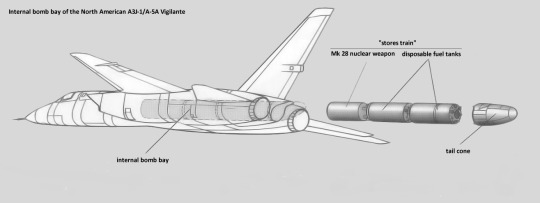
-Internal bomb bay and stores train of the North American A3J-1/A-5A Vigilante. | Illustration: Cobatfor
FLIGHT TESTING, INTRODUCTION, AND SERVICE
First flight of the XA3J was on 31 August 1958 from the same Columbus, OH plant that produced the F-86 and F-100s. Despite one of the prototypes crashing in 1959, the flight tests moved quickly, and by June 1961 the first A3J-1s entered service with Heavy Attack Squadron Three (VAH-3) at NAS Stanford, FL, replacing the Douglas A3D Skywarrior. The following year the plane was redesignated the A-5A under the new tri-service plan. The service life of the A-5A was fraught with issues, with numerous teething problems plaguing its advanced systems. These issues were tamed as maintenance crews became experienced with the Vig's high-tech gadgets, but the plane remained maintenance-intensive (a so-called "hangar-queen") throughout its life. A chronic issue was the stores train bomb release, which had a nasty habit of releasing during catapult shots, resulting in at least one crash. During tests, the train also tended to draft along in the aircraft's slipstream, making accurate bombing (for 1950s/60s definitions of "accurate") difficult.
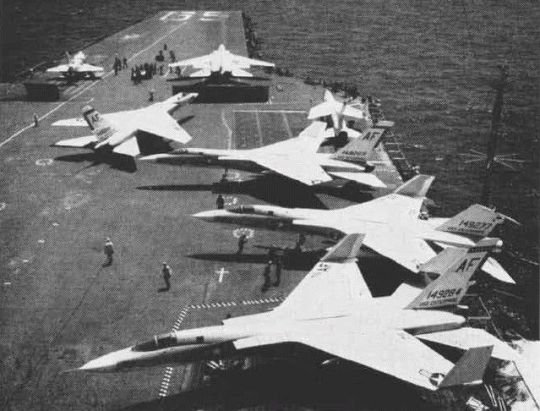
-Five A3J-1 Vigilantes of VAH-7 ("Peacemakers of the Fleet") on CVAN-65 USS Enterprise in 1962. | Photo: USN
Fifty-eight A-5A were completed (out of an order of 64 aircraft) when NAA switched to the upgraded A-5B model. The B model incorporated changes made in light of the Navy's requirement that the Vigilante be able to take off at max weight with zero wind over the carrier being rescinded. This change allowed North American to increase the bomber's weight, adding a dorsal hump to carry more fuel. Only 18 of the A-5B were completed before the US Navy, undergoing a shift in policy away from manned nuclear bombers, canceled the order.
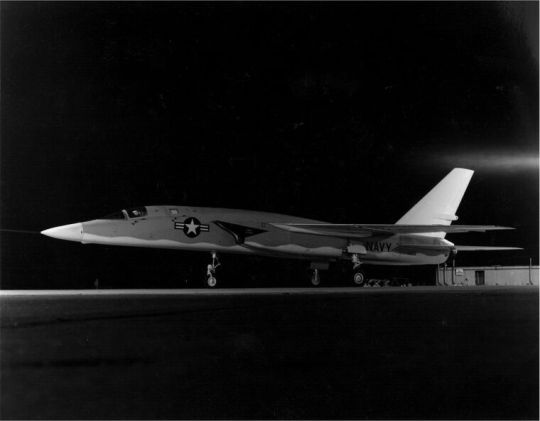
-North American A3J-2 Vigilante (BuNo 146699), circa 1960. This aircraft was the third production A3J-1 which was then modified to an A3J-2 (after 1962 A-5B and YA-5C) and finally to the A3J-3P (RA-5C). | Photo: US Navy
Developed from the A3J-2, the A3J-3P (later RA-5C) was a strike/reconnaissance variant of the Vigilante, incorporating the CCTV in the nose with a "canoe" fairing holding a full suite of gear including:
KA-51A/B forward-looking oblique angle film camera.
KA-50A, KA-51A, or KA-62A vertical film camera.
Passive electronics countermeasures (PECM) antenna for the AN/ALQ-61 Electronic Reconnaissance System. The AN/ALQ-61 was an "electronic intelligence (ELINT)" system that would pick up radar emissions and pin down their coordinates, frequency, and pulse pattern. The ELINT data was recorded on magnetic tape, with storage capacity for 112 minutes of continuous ELINT observations.
Various combinations of panoramic, vertical, or oblique film cameras. Camera fit included KA-58A panoramic camera for medium- to high-altitude work, or a KA-57A panoramic camera for low-altitude work. The cameras shot through prisms in the canoe that could be pivoted to permit shots straight down or from side to side.
AN/AAS-21 infrared sensor, which could provide a continuous film strip of thermal targets, such as hidden trucks, over a field of view 140 degrees wide.
Antenna for the Westinghouse AN/APD-7 "side looking airborne radar (SLAR)" system, which shot radar pulses out to the side of the aircraft and stored the return echo on a long film strip, permitting all-weather, day-night imaging.
Another PECM antenna for the AN/ALQ-21 system.
Additionally, a flash pod, powered by a ram-air turbine in its tail, could be carried under one wing to provide illumination for nighttime recon. The sensors were operated by the back-seater (also known as a "GIB": guy-in-back), formally called a "reconnaissance-attack navigator (RAN)". The bomb bay was filled with semi-permanent fuel tanks (though the plane apparently retained the ability to carry offensive weapons, this was never tested or confirmed). The remaining A-5A and A-5B aircraft were all converted to RA-5C standards, along with 33 new-build aircraft. Squadrons that had formerly flown the A-5 were transitioned to the RA-5 beginning with VAH-3 in July 1963, becoming Reconnaissance Attack Squadrons (RVAH) as they did so. Eventually ten squadrons of RA-5s were established, with the NAS Stanford RVAH-3 being joined by carrier-based RVAH-1, RVAH-5, RVAH-6, RVAH-7, RVAH-9, RVAH-11, RVAH-12, RVAH-13 and RVAH-14.
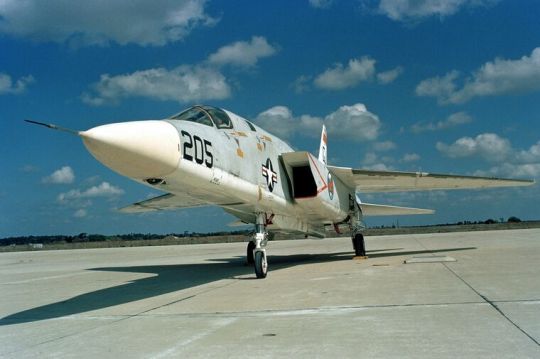
-RA-5C Vigilante of Reconnaissance Heavy Attack Squadron 3 (RVAH-3) "Sea Dragons" is parked on the flight line at Naval Air Station Sanford, Florida, on 27 March 1968. - | Photo: US Navy
Starting in July 1964, the RA-5Cs saw extensive service over Vietnam, carrying out dangerous post-strike damage assessment missions. Although fast and nimble, the Vig proved vulnerable to ground fire, with 14 RA-5s lost to AAA, 3 to SAMs and one shot down by a NVA MiG-21. Nine more were lost to accidents, and as a result three dozen additional aircraft were built between 1968 and 1970. Despite providing invaluable reconnaissance data, the RA-5 began to be phased out starting in 1968, with NAS Stanford being closed and the Vigilante's parent wing, Reconnaissance Attack Wing One, being transferred to Turner AFB in Georgia, which was turned over to the Navy and renamed NAS Albany. Barely six years later, NAS Albany was closed as a result of post-Vietnam drawdowns, and the remaining RA-5s were transferred again to NAS Key West. As newer and larger aircraft like the F-14 and S-3 were introduced in the mid-70s, the Navy began disestablishment of the RA-5 squadrons, with the last leaving Key West on 20 November 1979.
NASA, THE RAAF, AND THE USAF
At least one A3J-1 was bailed to NASA for a time while the Dryden FRC was participating in research for the US SST program. In 1962 Vigilante BuNo 147858 was given NASA tail number 858 and was flown by NASA pilot Bill Dana on 21 flights along airways around LAX to determine approach conditions for an SST landing patterns. After the conclusion of the program, the plane was returned to the Navy.

-NASA's A3J-1, wearing a day-glo orange tail flash, on 19 December 1962. | Photo: NASA DFRC
The RAAF was interested in the A-5 as a possible replacement for their aging Canberra bombers, considering the Vig alongside the F-4, Dassault Mirage IVA, BAC TSR-2 and F-111. Despite the A-5 being available without the delay anticipated for the F-111, the order for three dozen Vigilantes was not issued.
At some point in the Vigilante's development, North American advanced a proposal to the Air Force for the 'Retaliator', an A-5 with a liquid rocket added to the bomb bay, as an interceptor, but the USAF showed no interest. In 1972 NAA again proposed a modified A-5, known internally as the NR-349, to the USAF as an Improved Manned Interceptor. The internal bomb bay was modified to house a third jet, and six AIM-54 Phoenix missiles would be carried under the fuselage. Again the USAF was uninterested.
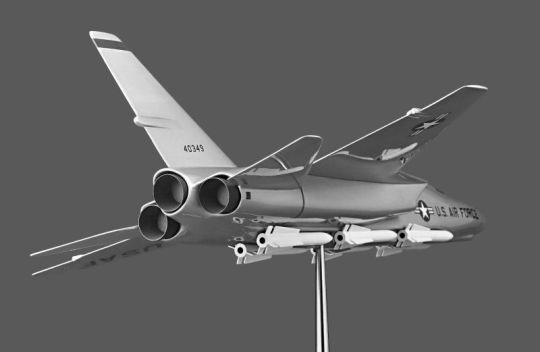
-Scale model of the Improved Manned Interceptor concept, in USAF markings. | Model: NAA/Rockwell
SURVIVORS
By 2004, all of the surviving RA-5s that had been retired to AMARG had been either scrapped or preserved as museum aircraft. A limited number of aircraft were still in storage at NAWS China Lake for eventual use in weapons tests. Around a dozen aircraft have been retained in museums around the US, with only one A-5A on display at NAS Pax River in Maryland, the balance being RA-5s.
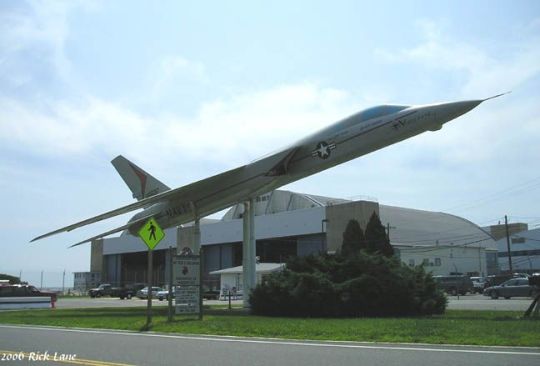
-BuNo 146697, the sole remaining A-5A, on display at Pax River. | Photo: Richard Lane
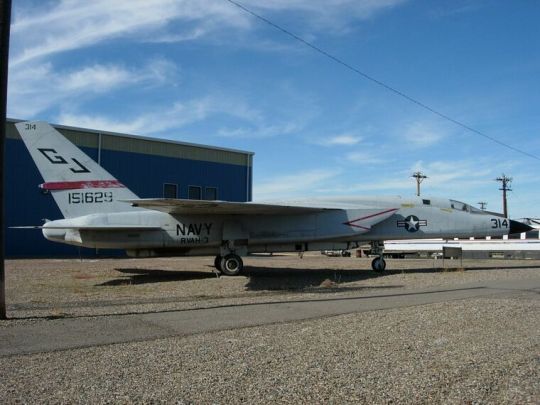
-RA-5C Vigilante (BuNo 151629) on display at the Pueblo Weisbrod Aircraft Museum. It wears the markings of the fleet replacement squadron RVAH-3 Sea Dragons. | Photo: Kristian Jones
#aircraft#aviation#avgeek#airplanes#cold war#airplane#cold war history#coldwar#aviation history#us navy#usn#north american aviation#north american a 5a#a3j-1 Vigilante#a-5a Vigilante#a5a Vigilante#a 5a Vigilante#ra5c Vigilante#ra5c
41 notes
·
View notes
Video
NATC A3J-1 Vigilante BuNo 146697 by G. Verver
Via Flickr:
NATC Patuxent River A3J-1 Vigilante BuNo 146697 conducted the type's initial carrier suitability tests aboard the USS Saratoga (CVA-60) during the week of 25 July 1960. Piloted by NATC's Cdr. Carl Cruse, LCdr. Ed Decker and Lt. Dick Wright, the Vigilante made 14 successful launches and arrested landings.
12 notes
·
View notes
Photo
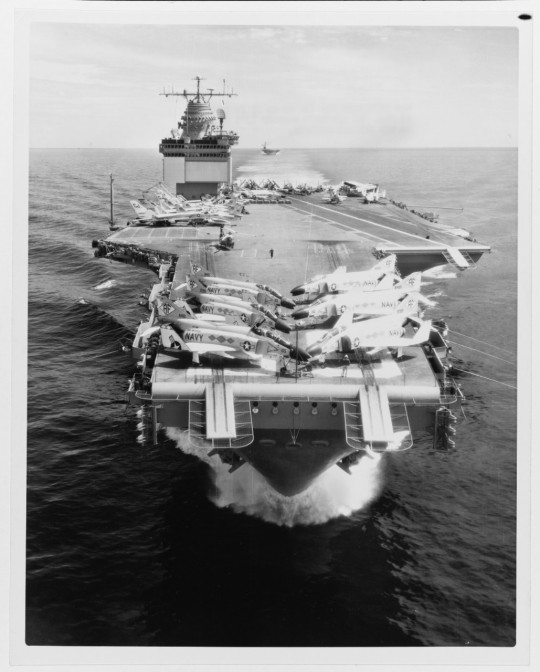
Underway at sea on 10 April 1962, with another carrier astern. Planes on deck include: McDonnell F4H-1 Phantom II fighters (Bu#s 148400, 148413, 148396, 148402, 148398, 148425, and 148388), North American A3J-1 Vigilante attack planes (Bu#s 148927 and 147863), Douglas A4D-2N Skyhawk attack planes (Bu#s 148572, 148568, and 148579). F4Hs are from VF-102. A3Js are from VAH-3.
40 notes
·
View notes
Text
A3J-1 Vigilante – Aerospace Projects Review Blog
A3J-1 Vigilante – Aerospace Projects Review Blog
Back in the day, aerospace companies would actively court the public, including those crazy kids who liked to make models. To that end, a number of aerospace companies would release surprisingly nice diagrams of their aircraft. North American Aviation was one such company, and one of their aircraft that they diagrammed for the public was the A3J-1 (later A-5) Vigilante supersonic carrier based…
View On WordPress
0 notes
Photo

U.S. Navy North American A3J-1 Vigilante nuclear bombers from heavy attack squadron seven VAH-7 Peacemakers of the Fleet on flight deck of the aircraft carrier USS Enterprise (CVAN-65). 1962. (U.S. Navy NMNA )
0 notes
Photo




The B28, originally Mark 28, was a thermonuclear bomb carried by U.S. tactical fighter bombers, attack aircraft and bomber aircraft. From 1962 to 1972 under the NATO nuclear weapons sharing program, American B28s also equipped six Europe-based Canadian CF-104 squadrons known as the RCAF Nuclear Strike Force. It was also supplied for delivery by UK-based Royal Air Force Valiant and Canberra aircraft[1] assigned to NATO under the command of SACEUR. In addition, certain U.S. Navy carrier based attack aircraft such as the A3D (later A-3B) Skywarrior, A4D (later A-4) Skyhawk, and A3J (later A-5A) Vigilante were equipped to carry the MK 28.
https://en.wikipedia.org/wiki/B28_nuclear_bomb
0 notes
Photo

North American A3J-1 Vigilante, BuNo 146700, c/n NA247-9, crashes over NAS Patuxent River, Maryland. Pilot Lt. Cdr. Grimes ejects safely.
0 notes
Video
NATC North American A3J-1 Vigilante 147852 by Wing attack Plan R
Via Flickr:
The Vigilante, designed and built for the U.S. Navy by North American Aircraft Division at Columbus, Ohio, was the only Mach 2 bomber to serve aboard a Navy carrier. Initially designated the A3J-1 attack bomber, it was one of the largest and heaviest aircraft ever accepted for service aboard U.S. Navy carriers. Production began in 1956, and it entered squadron service in June 1961. It was redesignated the A-5 and fully deployed by August 1962, when the USS Enterprise, the Navy’s first nuclear aircraft carrier, made its inaugural cruise. Changing defense strategies marked a change of focus away from carrier-based, heavy-attack squadrons. In 1964, all the Vigilantes were reconfigured as reconnaissance aircraft and designated RA-5C. Reconnaissance gear was mounted in what had been the Vigilante’s bomb bay. Other modifications allowed the RA-5C to carry four external fuel tanks. These additions increased the airplane’s range on reconnaissance missions and allowed it to keep its attack capability with externally mounted bombs and rockets. The RA-5C Vigilante first flew on June 30, 1962, and was capable of all-weather, long-range, carrier- or land-based, multisensor, reconnaissance missions involving high-altitude supersonic, or very low-altitude, high-speed penetrations. Its inertial navigation system provided the precise position location information demanded. The Vigilante pilot and the reconnaissance/attack navigator (RAN) sat in tandem under individual clamshell-type canopies. The RAN controlled all reconnaissance functions, although the pilot could assume control of the oblique-mounted serial frame cameras. Each crewmember had a catapult/rocket-powered ejection seat, also designed and produced at the Columbus facility, capable of high-altitude, high-speed or ground-level recoveries. The RA-5C featured a high, thin swept wing and all-movable slab-type tail surfaces with spoiler/deflectors in lieu of conventional ailerons for lateral control. The wing was equipped with flaps and droopable leading edges with boundary layer control, which, when used in conjunction with the spoiler/deflectors, improved low-speed flight characteristics. The combination of the RA-5C Vigilante’s ability to deliver conventional weapons, day or night in all kinds of weather, as well as to complete tactical reconnaissance missions made it one of the most versatile aircraft in the world. RA-5Cs served throughout the Vietnam War and were retired from service in 1979. 147852, C.N. NA263-3. Converted to RA-5C Vigilante. Withdrawn from service to MASDC 10 January, 1974 as AA 4A0027. S.O.C. 1 August 1974. Transferred to China Lake Weapons Center 6 April, 1979. Photo Credit's: Unknown to me (Reprint scan) Photo thought to have been taken at Paris Airshow 1960.
4 notes
·
View notes
Text

APRIL 1962 USS Enterprise. Visible in front are McDonnell F4H-1 Phantom IIs (BuNo 148400, 148413, 148396, 148402, 148398, 148425, and 148388) from VF-102 Diamondbacks from CVG-6 (tail code "AF"). In front of the island are North American A3J-1 Vigilantes from Heavy Attack Squadron 3 (VAH-3) "Sea Dragons" (tail code "GJ") and VAH-7 "Peacemakers of the Fleet" (tail code "GL"). Also visible are Douglas A4D-2N Skyhawks from Attack Squadron 64 (VA-64) "Black Lancers" (tail code "AF") and VA-172 "Blue Bolts" (tail code "AB"). NHHC USN
@kadonkey via X
26 notes
·
View notes
Text

A-5A (A3J-1), later converted to RA-5C, "Vigilante" (149276/AB-602 & MSN: 269-11/296-55/C-052) of the RVAH-14 "Eagle Eyes", next to a F-4B-12-MC (F4H-1) "Phantom" II (150425/AB-113) of the VF-14 "Tophatters", embarked on USS John F. Kennedy (CVA 67), June 1969.
@TOYRU1963 via X


12 notes
·
View notes
Text
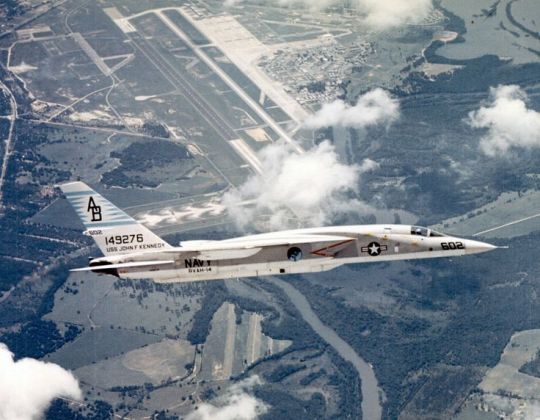
Attack "A": North American A-5/RA-5 Vigilante
LaMarca By LaMarca 12/04/2022 - 17:55 in History, Military
A June 1969 aerial view looking southwest at a beautiful North American RA-5C Vigilante of RVAH-14 in flight over NAS Albany.
The Vigilante was an average nuclear bomber, operated from aircraft carriers, developed due to the determination of the US Navy to expand its attack capacity with nuclear weapons.
The development of Vigilante began in November 1953, under the name "NAGPAW - North American General Purpose Attack Weapon". The objective was to develop an aircraft that reached 2 times the speed of sound and had a service ceiling of 52,500 feet (16,000 meters).
The role of the on-board nuclear bomber had already been played by 2 other aircraft, also from North American, AJ Savage and the A-3 Skywarrior, which quickly became obsolete for the missions that were originally designed
According to the requirements, the new bomber should be twin-engine and have an innovative compartment for transporting a nuclear weapon, at the rear of the fuselage, under the tail and between the exhaust fans of the engines, thus increasing the chances of survival to the atomic explosion.

North_American_A-5A_internal_bomb_bay
Gray area is the weaponry compartment. Behind, the representation of the nuclear bomb, in addition to the 2 additional fuel tanks, disposable.
The basic project was exposed to the US Navy in 1954, and after some changes, resubmitted and approved in April 1955, resulting in the signing of a letter of intent, on June 29, 1956, for the construction of two prototypes (serial numbers 145157 and 145158), officially designated YA3J-1, and North American proposed the name Vigilante for the new aircraft.
North American A-5 Vigilante prototype

1º Vigilante prototype, serial number 145157.
A-5-with-truck

2º Vigilante prototype, serial number 145158.
The first flight was made on August 31, 1958, with the head of the North American test pilots, Dick Wenzel, at the command.
One of the prototypes in embedded evaluation, note the folded vertical stabilizer (North American Aviation)

4ª production aircraft, serial number 146697, conducting tests on board the USS Saratoga (CVA-60), on July 25, 1960. Photo: US Navy
His introduction to active service took place in June 1961 at Stanford's Naval Air Station in Florida.
A-5A_Vigilante_ejection_seat_test_NAN1-89

Crew member being ejected on test flight. Photo: US Navy
In the US Navy, the Vigilante was initially designated A3J, but this name was later changed to A-5 in September 1962, due to the internal reorganization in the nomenclature of aircraft operated by the USAF and US Navy.
d4965f0e1c199e75b17ce76d8662c093
In all respects, the Vigilante was an innovative aircraft, introducing new technologies in the aerodynamic, structural and electronic segment, some of which were only applied again in production aircraft, almost two decades ago.
800px-A-5A_Vigilante_cockpit_control_panel
It was the second heaviest aircraft to operate on board, second only to its immediate predecessor, the Skywarrior.

North-American-VigilanteIts main structures were made of titanium, and the lining of the wings with lithium added to the aluminum alloy. Both solutions to save mass, since the plane was very large for US Navy ships, which had previously been modified to accommodate and operate the A-3 Skywarrior.
RVAH-1 Smokin' Tigers RA-5C Vigilante AG-601 ready for launch from the USS Independence, circa 1965. Photographer unknown.
On a master balcony, North American chose the same thrusters as the McDonnell Douglas F-4 Phantom II for the motorization of the Vigilante, whose engine air intakes had variable geometry, adjustable to the speed of the aircraft. The General Electric J79 was a very powerful turbojet, having been the first production engine capable of providing an aircraft with twice the speed of sound.
RVAH-11 RA-5C escorted by a VF-213 F4 over the Gulf of Tonkin

As the Phantom was the front line of the embarked fighters, the adoption of the same propulsion systems facilitated maintenance on board the aircraft carriers.

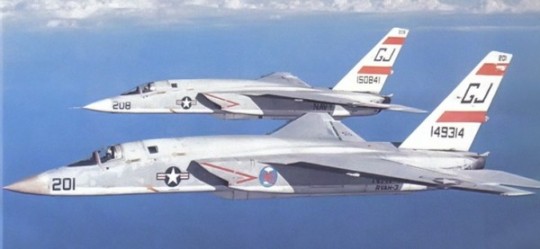
The embedded electronics were sophisticated and, in many ways, unprecedented. Advanced electronic characteristics of the aircraft:
First use of the fly-by-wire flight control system in non-experimental production aircraft.
Digital navigation and bombing computer.
Operational use of the HUD device for the first time.
Automatic inertial navigation bombardment system self-coupled to the radar and television camera for coordinate verification, previously inserted.
First use of single-pulse radar to track the terrain, avoiding obstacles.
1024px-A3J-1_and_F8U-1_launch_from_USS_Enterprise_CVAN-65_1962
This was a period when enemy reaction capacity had improved significantly, with the improvement of ground-to-air missiles. There was a legitimate concern on the part of American military commanders, still frightened by the shooting down of Francis Gary Powers' U-2 over the USSR in 1960.
800px-A-5A_Vigilantes_of_VAH-1_being_readied_for_launching_c1964
A-5A_Vigilante_of_VAH-1_being_launched_c1964
Also in 1961, the first submarines armed with Polaris missiles became operational, which, ironically, contributed to the fact that, in the same year that the Vigilante was introduced into force, it was removed from active service as a nuclear attack aircraft. This caused the aircraft to go through a period of contempt, relegated to training missions, until July 1963, with the presentation of the RA-5C tactical recognition variant.
CVW-11 RVAH-6 Fleurs RA-5C Vigilante BuNo 156632, NH-602, aboard the USS Kitty Hawk (CVA-63) 7 April 1975. HS-8 SH-3G Sea King BuNo 154116 is at right.
d4130efc400c93d0d72e4319b6acc98d
A-5C Vigilante
RVAH-6 Fleurs RA-5C Vigilante BuNo 151617, NG-603, trapping aboard the USS Enterprise, 1969. Photographer unknown.
RVAH-6 Fleurs RA-5C Vigilante NL-701 ready for launch from the USS Constellation, 1966. Photographer unknown. VA-153 Blue Tail Flies A-4C NL-314 at left.
The Vigilante was an ideal platform for this function, allowing recognition at low altitude, because speed would be a great factor of rapid and surprising penetration into enemy territory.
763px-Camera_loading_on_RA-5C_Vigilante
Installation of cameras and electronic equipment, used in tactical reconnaissance missions.
Another positive point was the fact that the aircraft's internal weapons compartment served perfectly for the installation of the photographic cameras, along with all the electronic paraphernalia necessary for reconnaissance missions.
North American A-5 Vigilante
North American A-5 Vigilante 3
zoom-VIG15 copy
zoom-VIG15a copy
Compared to previous versions, the RA-5C incorporated a series of modifications, one of them being the landing gear, which was reinforced to withstand more durability the huge blows resulting from the severity of landings on aircraft carriers. Internal fuel tanks were added, generating the cork above the fuselage.
a-5_1
a-5_3
The RA-5C was the most efficient version of Vigilante. The aircraft had a slightly larger area, to compensate for the largest mass transported, about five tons, from the cameras. Even with the internal compartment occupied, an addition below the fuselage was made to accommodate infrared, brightness and other sensors.
A3J-1_with_crew_on_USS_Enterprise_CVAN-65_1962
36c9d40c895c1f6b680e67ddfab37b9b
There was also a side surveillance radar and an infrared scanner to detect living beings. Side radars are necessary to avoid as much as possible the overflight of enemy areas, with the plane being able to pass at the edges of the danger, and not directly over it.
In June 1964, the RA-5C was introduced into the active service. In all, 10 squadrons were formed with the aircraft, of which 8, just 2 months later, were already in Vietnam.
Camouflaged_RA-5C_of_RVAH-13_over_Tonkin_Gulf_1966
The first missions were to photograph targets, before and after the attacks, flying at about 2,400 m altitude, which was considered very low, and of very high risk. The only existing protection for aircraft was speed. Several were shot down, which made it the US Navy aircraft with the highest friction rate in the conflict. In all, 19 aircraft were lost in combat, out of a total of 26 throughout the war. The higher speed of the Vigilante, in relation to other aircraft, such as the Vought F-8 Crusader, for example, practically made the possibility of sending effective escorts unfeasible. To give you an idea, the Vigilantes left after the attack planes, and managed to overtake them.
631cc6880def2ec663ecec8328d3c6cc
In one of the missions, in December 1967, it was determined that an RA-5C, serial number 149299, would check the center of Hanoi, in search of the location of the prison camp where the Americans were. Flying fast and low, the Hoa Lo prison, nicknamed Hanoi Hilton, was photographed for the 1ª time. With the exact location, political pressure against Vietnam has increased, resulting in the gradual release of all prisoners.
Despite its excellent services, the Vigilante was considered expensive and complex to operate, in addition to occupying a precious space on board the American aircraft carriers.
Vigilante - USS Constellation (CV-64)
On board the USS Constellation (CV-64). In this image it is possible to compare the size of the Vigilante in relation to other aircraft.
With the end of the Vietnam War already taken for granted, from 1974, the reconnaissance squads began to be deactivated. His last mission took place in 1979, with the aircraft having been retired on November 20 of the same year.
zoom-VIG19 copy
Three legends of American embarked aviation: RA-5C Vigilante, A-7 Corsair II and A-6 Intruder, flying over the USS Nimitz.
DN-SC-04-09230
North American A-5 Vigilante 1
A-5A Vigilante. Photo: Del Laughery
North American A-5 / RA-5 Vigilante
Variants:
YA3J-1 / YA-5A: two prototypes built, first flew on August 31, 1958, with the head of North American test pilots Dick Wenzel at the controls.
A3J-1 / A-5A: nuclear attack bomber, in all weather conditions, day and night, based on aircraft carriers, began operational activity on board the USS Enterprise (CVN-65) in August 1962.
A3J-2 / A-5B: similar to A3J-1 / A-5A, but incorporating a larger central fuel tank, and leading edge FLAPS to increase lift and stability at low speeds.
A3J-3 / RA-5C: embedded version of strategic recognition.
VIGILANTE - AIRCRAFT BUILT
DN-SC-88-06708
VIGILANTE - CHARACTERISTICS
Four models of the General Electric J79 engine were used in the various versions of the Vigilante, with the following escalation:
J79-GE-2: In the two prototypes and in the initial production models of the A3J-1/A-5A.
J79-GE-4: In the A3J-1/A-5A of interim production, in which steel was used to replace the magnesium alloy in the exhaust hoods and in the front moldings of the air intakes.
J79-GE-8: In the latest A3J-1/A-5A, in all A3J-21/A-5B and in the initial production models of the A3J-3/RA-5C version.
J79-GE-10/10B - In the last 36 copies produced of the A3J-3/RA-5C.
ABViggie 00001 North American RA-5C Vigilante Official US Navy photo produced by Peter J Mancus-L
Armament:
1 free-fall nuclear bomb of the type Mark 27, B28 or B43, in the internal weapons compartment.
2 free-fall nuclear bombs of type Mark 83, Mark 84 or B43, at the fixed points under the wings.
The initial project also provided for the wide use of a mix of conventional weapons, along with nuclear, which would be transported at 4 fixed points under the wings, in addition to the internal weapons compartment.
VIGILANTE - WEAPONS
Curiosity:
When the Vigilante was in the initial stage of its development, it was considered a configuration where the aircraft would have a double tail, A mockup was even built, as can be seen below:
Mock-up of the North American Aviation A3J (A-5A) Vigilante
North American Aviation A3J (A-5) Vigilante supersonic, carrier-based nuclear strike-bomber mock
SOURCE/PHOTOS:
North American Aircraft 1934-1999, Volume 2, Kevin Thompson, Narkiewicz//Thompson, 1999
American Combat Planes, 3rd Edition, Ray Wagner, Doubleday, 1982.
United States Navy Aircraft Since 1911, GordonSwanborough and Peter M. Bowers, Naval Institute Press, 1990.
North American Rockwell A3J (A-5) Vigilante, M. Hill Goodspeed, Wings of Fame, Vol 19, 2001.
US Navy.
The Editor's private collection, and internet.
PREVIOUS: McDonnell Douglas A-4 Skyhawk
NEXT: Grumman A-6 Intruder
Tags: THE ATTACKHISTORYMilitary
LaMarca
LaMarca
Related news
HISTORY
HISTORY: 68 years ago, Sud Aviation Caravelle made its first flight
28/05/2023 - 10:00
HISTORY
May 1973: My first combat mission with the F-4 over Cambodia
21/05/2023 - 09:00
MUSEUMS
Last Blackburn Beverley aircraft in the world is in danger of becoming scrap
05/14/23 - 10:00
EXECUTIVE
Dassault celebrates 60 years of Falcon executive jets
07/05/2023 - 23:24
HISTORY
FALKLANDS/MALVINAS: The history of the RAF Mount Pleasant Base
18/03/2023 - 16:00
HISTORY
F-20 Tigershark: a F-5 with steroids
12/03/2023 - 22:46
homeMain PageEditorialsINFORMATIONeventsCooperateSpecialitiesadvertiseabout
Cavok Brazil - Digital Tchê Web Creation
Commercial
Executive
Helicopters
HISTORY
Military
Brazilian Air Force
Space
Specialities
Cavok Brazil - Digital Tchê Web Creation
8 notes
·
View notes
Text
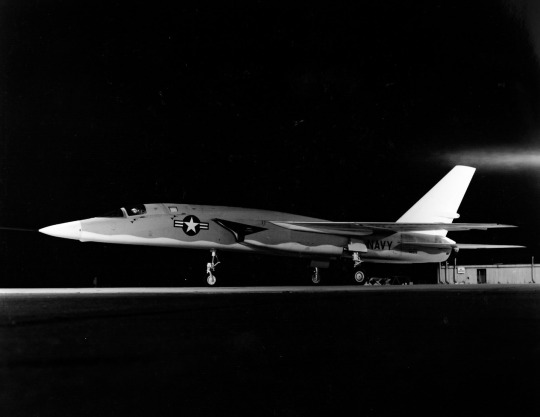
A U.S. Navy North American A3J-2 Vigilante (BuNo 146699). This aircraft was the third production A3J-1 which was then modified to an A3J-2 (after 1962 A-5B and YA-5C) and finally to the A3J-3P (RA-5C). ca. 1960. USN NMNA
@kadonkey via X

4 notes
·
View notes
Text
G. Verver Following
NWEF A3J-1 Vigilante BuNo 147857, NWEF-857, inflight, date unknown. Photo by Clay Jansson.
Naval Weapons Evaluation Facility A3J-1 Vigilante BuNo 147857, NWEF-857, inflight, date unknown. Photo by Clay Jansson.
7 notes
·
View notes
Text
G. Verver Following
VX-5 Det A NASWF A3J-1 Vigilante BuNo 147856
VX-5 Vampires Det. A NASWF Albuquerque A3J-1 Vigilante BuNo 147856 inflight over the desert, circa 1962. Official U.S. Navy photo.
4 notes
·
View notes
Text
G. Verver Following
VX-5 Det A NASWF A3J-1 Vigilante BuNo 147856
VX-5 Vampires Det. A NASWF Albuquerque A3J-1 Vigilante BuNo 147856, runway 21, China Lake, circa 1962. Probably flown by VX-5 Detachment Alpha from Kirtland AFB, Albuquerque, NM. Photographer unknown.
3 notes
·
View notes




